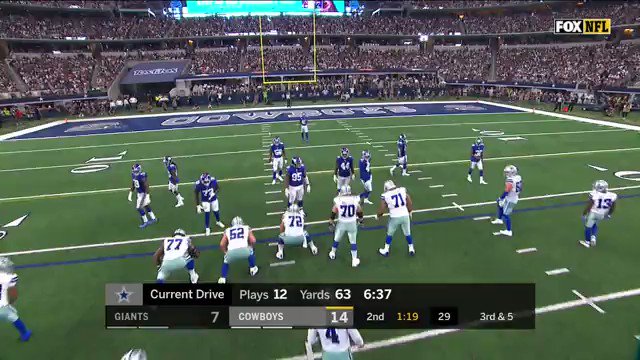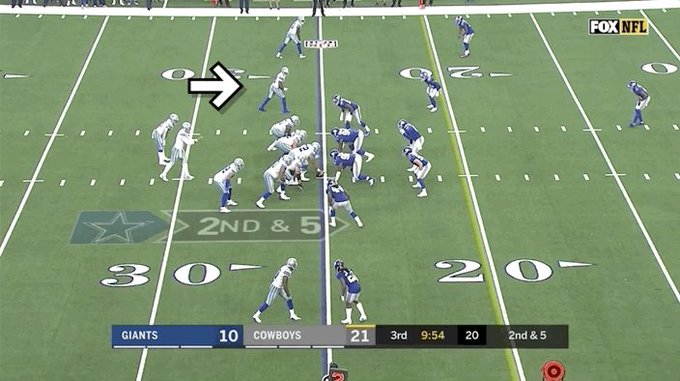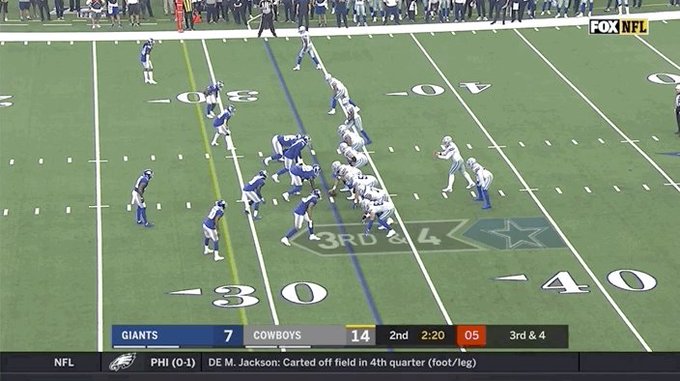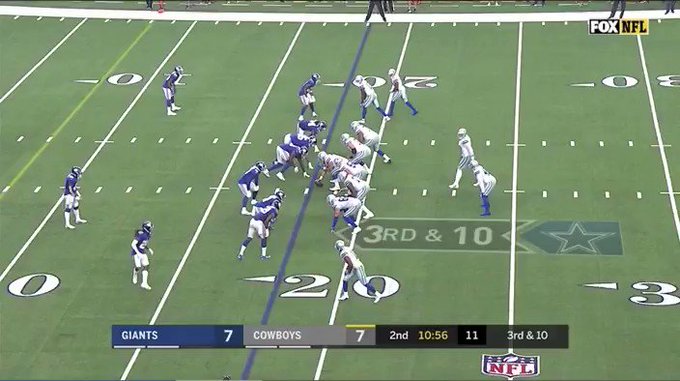Film room: 3 things we learned about the Kellen Moore-led Cowboys offense against the Giants
Things couldn’t have gone better for Moore in his regular-season debut as play-caller of the Dallas Cowboys’ offense.
/arc-anglerfish-arc2-prod-dmn.s3.amazonaws.com/public/VZ75UWUJFCFPHGQ42ZIHRGVRWQ.jpg)
By John Owning
4:00 PM on Sep 9, 2019
How about that for a debut?
Things couldn't have gone better for Kellen Moore in his regular-season debut as play-caller of the Dallas Cowboys' offense, which put up 494 total yards in a dominant 35-17 win over the New York Giants.
The defense certainly played well, too, but the Moore-led offense is undoubtedly the talk of Cowboys Nation.
Moore's alterations to the offense were as good as advertised. There was a plethora of pre-snap movement, play action, condensed receiver splits, bunches and stack releases in the pass game, all of which enabled Dak Prescott to slice and dice the New York defense. Moreover, the offense mixed tempos, used misdirection and displayed great formation diversity to keep the Giants on their toes.
With that in mind, let's spin this week's "Things We Learned" post in a new direction by detailing a few important things gleaned from watching Moore's offense against the Giants.
Play action, pre-snap movement and outstanding play design pay dividends
There were myriad examples of the new wrinkles Moore has added or emphasized for the offense, so we are going to make it easy and break down each of Prescott's four touchdown passes to illustrate the first-year coordinator's effect on the Cowboys, starting with the throw to Blake Jarwin in the first quarter:
The Cowboys were in a shotgun formation on this play, using 11 personnel (three wide receivers, one running back and one tight end) with three weapons to the right of the formation (Amari Cooper, Randall Cobb and Jarwin).
Once the ball is snapped, Prescott executes a great play-action fake -- which, combined with Connor Williams (No. 52) pulling to the right side of the formation, causes the second level of the Giants' defense and the near-side safety to bite on the run action.
With the linebackers and near-side safety sucked up to the line of scrimmage, Jarwin is left wide open down the middle of the field for the easy pitch-and-catch touchdown.
Another great aspect to the play design was Cobb's vertical route from the slot, as it kept the far-side safety from picking up Jarwin, who was attacking the middle of the field. If Jarwin was the only vertical threat, that safety likely would have been in position to potentially prevent the touchdown or completion as a whole.
The play design and play action was so good that it didn't matter if Prescott's throw was behind Jarwin, as there wasn't a Giants defender within 5 yards of the tight end.
On Dallas' second touchdown of the game, Moore dialed up another play-action pass for a touchdown:
Welcome back to Dallas, Jason Witten! #NYGvsDAL
364 people are talking about this
On this play, the Cowboys were in a single-back set -- once again using 11 personnel -- with two weapons to each side of the formation (Michael Gallup and Cobb to the offense's left; Jason Witten and Cooper to the right).
When the ball is snapped, the Cowboys sell an outside zone run with a hard play-action fake from Prescott and Ezekiel Elliott, while the offensive line expanded laterally toward the wide side of the field.
After selling the play-action fake, Prescott rolled out to his right and found a wide-open Witten for the touchdown.
This was another example of Moore scheming a weapon open for Prescott in the passing game, as Witten's delayed route to the flat helped sell the run action, helping cause the Giants' front seven to bite on the fake. Witten did an excellent job of selling his block, as it led to Giants safety Michael Thomas (No. 31) flying up to the line of scrimmage to defend the potential run. That then enabled the veteran tight end to leak into the flats and run to the end zone for the score.
Prescott's third touchdown was certainly one of his best throws of the day, but it was perfectly set up by Moore's pre-snap movement and manipulation of the defense:
Them: AmArI cOoPeR aNd DaK pReSsCoTt SuCk
Amari and Dak:
101 people are talking about this
On this play, the Cowboys are once again in a shotgun formation with 11 personnel, but this time, they initially align in a 2x2 formation with Jamize Olawale in the backfield, Cobb and Cooper to the left of the formation, and Witten and Gallup on the right. But before the ball is snapped, Cobb motions to the right side of the formation to create a condensed trips formation with Cooper singled up on the edge.
The cornerback mirroring Cobb's motion confirms that the defense is in man coverage, meaning Cooper is isolated on the outside. As long as Prescott can hold the deep safety in the middle of the field long enough with his eyes, Cooper will have a one-on-one matchup against rookie cornerback DeAndre Baker, a matchup Cooper will win nine times out of 10.
Prescott knows he's going to Cooper before the ball is snapped, but once it is, he does an excellent job keeping his eyes down the middle of the field with a quick glance to his right as he drops back, holding the deep safety in the middle -- exactly how the play was designed.
From there, Prescott's arm talent took over as he laid a perfect pass to Cooper in the end zone for the touchdown. Cooper executed an excellent skip release to win outside leverage and create the space necessary to run by the rookie corner.
This touchdown was a perfect demonstration of great play design and outstanding execution -- something Cowboys Nation has been hoping for since Moore was promoted to offensive coordinator.
It was more of the same on Prescott's fourth touchdown pass, as the Cowboys used play action to suck up the second level of the Giants' defense to open space up down the middle of the field. However, it was Cobb who benefited this time (above clip).
With the Giants' defense playing to the Cowboys' previous tendency as a run-heavy team, the offense was able to have a ton of success off play action -- which, combined with pre-snap movement and top-tier personnel, enabled the unit to be extremely efficient as a whole throughout the game.
It's also important to note that Moore didn't come up with new plays. A lot of what he did was just dress up and disguise the team's core concepts from previous years while emphasizing different aspects of the offense -- namely play action, which the Cowboys used on 47% of their passes (almost double their PA rate from last season) -- more frequently than in the past.
Smart, situational play-calling
Even outside of the touchdowns, Moore showed outstanding situational play-calling to put the Cowboys in the best position for success.
Since entering the NFL, Prescott's feet have been among his most dangerous weapons, which is why it made all the sense in the world for Moore to call zone reads to leverage Prescott's running ability in certain short down-and-distances.
With the Cowboys blowing out the Giants, Moore didn't need to lean on Prescott's legs much in the second half, but he did dial it up twice to keep the offense moving in the first half.
Zone reads are a great way to create favorable running situations in short down-and-distances because they allow the offense to create a numbers advantage by leaving a defender unblocked and reading his movement. The rules for reading the unblocked defender are simple: if the unblocked defender crashes on the running back at the mesh point, the quarterback keeps the ball. If the defender stays home and doesn't bite, then the quarterback hands the ball to the running back.
The first zone read came on a second-and-4 situation in the middle of the second quarter:
On this zone read, Prescott is reading the initial movements of Giants outside linebacker Markus Golden (No. 44). With Golden crashing on Ezekiel Elliott at the mesh point, Prescott correctly keeps the ball and burst toward the edge for the first down.
It was a nice job by Prescott to outrun Alec Ogletree (No. 47) -- who was influenced inside by the potential of an Elliott run for the first down -- but he needs to be mindful of sliding once he passes the sticks, as it makes no sense to take unnecessary punishment if the first down is already secured.
The second zone read came later in the same drive, when Moore dialed it up to pick up a first down on a third-and-4:
Even with Olawale as the lone back, the defense still bit hard on the running back at the mesh point (eyes on No. 53). Combined with the blocks by Witten and Olawale, who peeled back to make an impressive block after the mesh point, this gave Prescott the alley he needed to pick up the first down.
That third-down conversion turned out to be pretty important, as Prescott found Cooper for a touchdown just three plays later.
The Giants got hip to Prescott keeping the ball on zone reads, as the unblocked defender stopped crashing to the running back and started to remain patient in his gap to take the quarterback. This benefited Elliott.
Look at all of that pre-snap movement and misdirection by Kellen Moore!
67 people are talking about this
Here, the unblocked defender, Oshane Ximines (No. 53), stayed home to defend the QB keeper off the zone read, which forced Prescott to hand the ball to Elliott on a zone concept. Elliott did a good job of following the outstanding blocks by Tyron Smith and Williams to get to the second level before veering outside and cutting upfield toward the end zone.
It was another example of Moore dialing up a great play given the situation and defensive call to go along with outstanding execution by the players. It also displayed how play calls earlier in the game can manipulate the defense in a way that creates a scoring opportunity later in the game, which is exactly what you want an offensive coordinator to do.
Great use of bunch formations and stack alignments to create free releases for the receivers
From a play-design perspective, Moore also used a large number of stack and bunch alignments to give his receivers free releases off the line of scrimmage -- something that has been missing from Dallas' offense in recent years.
Here's an example:
On this play, the Cowboys faced a tough third-and-long situation. So, they come out in a shotgun formation using 11 personnel with a 2x2 set (Witten and Cooper to the offense's left; Cobb and Gallup to the right).
While many were (rightfully) impressed by Cobb's ability to create yards after the catch and pick up the first down, that would ignore how the free release earned by the stack alignment gave him the space he needed to elude the defender.
If Cobb was in a traditional alignment, the cornerback would have had a tighter alignment, which likely would have put him in closer proximity to Cobb once he hauled in the pass. With less space, Cobb wouldn't have had time to turn, square up the defender and use his free hand to clear contact. Instead, he would have likely been dragged down short of the sticks, forcing Dallas to settle for a field goal.
Altogether, it was a sensational debut by Dallas' new offensive coordinator in a game against a division rival.
Nevertheless, it's important to note that we still need to see how Moore reacts once defensive coordinators get enough of his offense on tape, as an offensive coordinator's ability to counter on the fly is one of the foremost traits that separate the good play-callers from the elite ones.
Based on the offense's performances against New York, we know Moore is at least a good coordinator -- the jury is still out on whether he's a great one.


















0 Commentaires